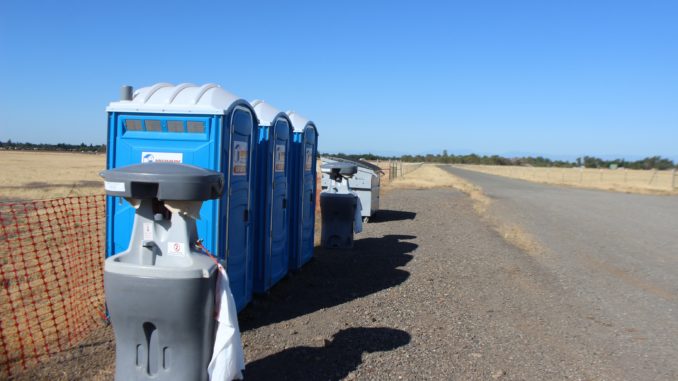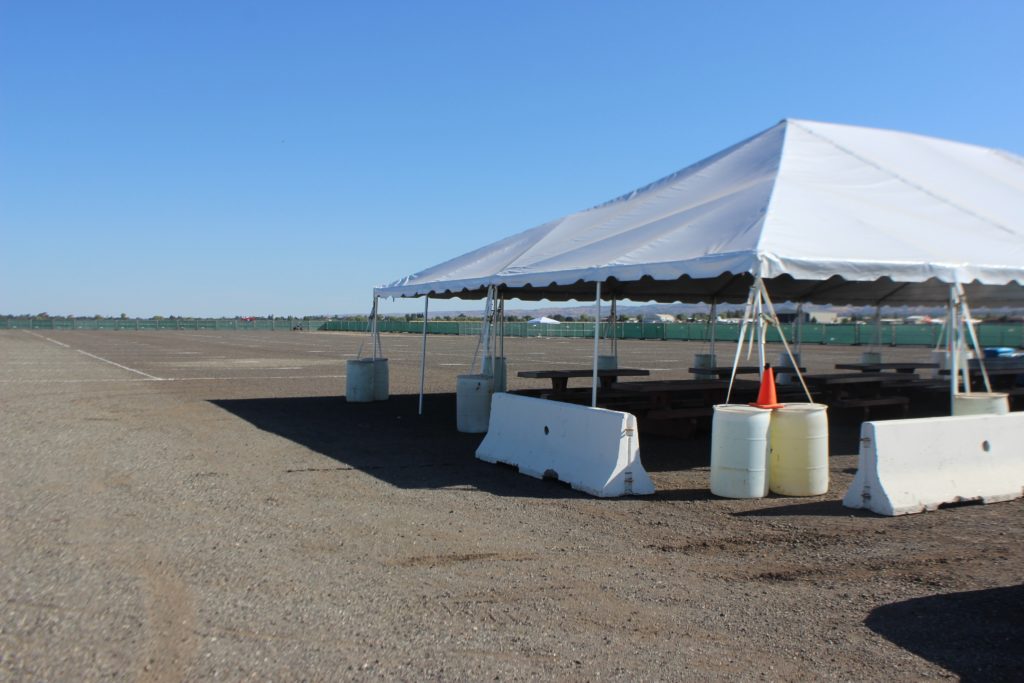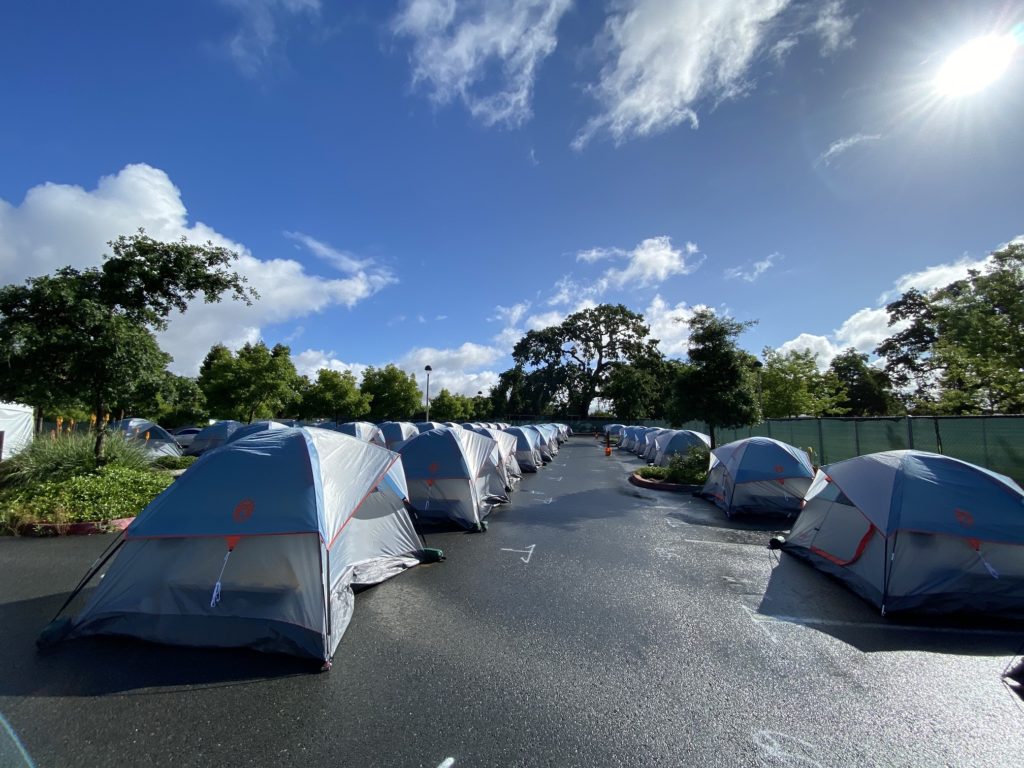
The day before the city of Chico opened its “resting site” for the local unhoused population at the Chico Municipal Airport last Friday (June 25), John Howlett stood in sweltering heat, peering through the fence at the end of Boeing Avenue toward a distant white tent in a field of brown grass on the far side of the runway.
After years of following the city’s ever-worsening homeless crisis and the city’s response to it, the former planning commissioner-turned-homeless advocate said he didn’t expect to be wowed by the City Council’s plan to provide shelter options to Chico’s homeless population, as ordered by a federal court judge in April. But after more than two months of closed-session council meetings, court extensions, the formation of an ad hoc committee and the untold amount of hours city staff spent exploring shelter solutions, he’d expected something more than the bare-bones facility the city offered.
Establishing one or more sanctioned campgrounds quickly became the focus of those ad hoc committee meetings—in which Howlett participated—with advocates and service providers bringing suggestions of best practices at such sites to the table. With the growth and visibility of illegal homeless encampments in the age of COVID—fueled by social distancing requirements leading to lessened capacity at congregate shelters and communities relaxing camping enforcement in keeping with the U.S. Centers for Disease Control and Prevention’s guidelines to limit the virus among the unhoused—several cities, including San Francisco and Sacramento, are currently experimenting with similar solutions. Others, like Santa Rosa, have already experienced some success by providing legal, safe spaces for campers.

“I was hopeful for about a day [after the ad hoc committee meetings] that they were actually going to listen, that maybe [the] City Council just wanted this all over with so bad that they’d do something good.” he said. “Now it’s clear they were just blowing smoke up everyone’s ass.
“There was so much good input in those meetings, and that has been brought to the council, and they didn’t take any of it, not one bit. And now,” he continued, indicating the faraway tent, “here’s what we’ve got.”
What that is is a fenced swath of hard-packed, sun-scorched aggregate with lines painted to delineate 571 spaces for parking and camping. There is no power at the site, with light provided by a handful of portable light towers. Amenities include the white “cooling tent,” two 275-water gallon potable water tanks, two hand-washing stations and three portable toilets. There are no other structures, or trees, to protect people from the triple-digit heat of summer. The city had yet to secure a service provider to manage the site when it became operational, though it had contracted with Armed Guard Private Security for round-the-clock security.
The site is meant to be temporary as the city works on the second phase of its plan, a more permanent facility where the Silver Dollar BMX track is currently located in south Chico. The only timeline offered by the city is that the latter site will be developed within the next year.
Howlett is not alone in his criticism. The city’s airport plan was met with a chorus of disapproval from advocates, service providers and unhoused individuals since it was first announced in court documents filed June 21 and made public the following day. On June 24, an organization called the California Homeless Union Statewide Organizing Council issued an open letter to the city threatening legal action. By the time the site opened, Butte County had also joined the list of detractors; a June 26 press release from the county’s Chief Administrative Officer, Andy Pickett, indicates the city’s facility falls far short of solutions discussed and planned in cooperation with the county. As a result, the county will not provide $500,000 in funding, nor other services it had committed to.
Howlett referred to the airport shelter as a “boondoggle,” a sentiment echoed by other critics who wonder why the city would waste taxpayer money on a project many doubt will appease the courts while offering no substantive solution—temporary or otherwise—to Chico’s homeless crisis.
Built to fail?
For the past several years, local homeless advocate Charles Withuhn has been looking into planned communities—like tiny-home villages and sanctioned campgrounds—as a way to provide shelter and services to the local unhoused population. He said that he’s proposed six detailed plans for such sites during that time, all rejected or ignored by both the current City Council and the previous left-leaning incarnation.

Withuhn founded the North State Shelter Team last year to help promote those solutions and to provide support—in the form of trash collection and food and water delivery—to existing illegal encampments that sprang up during the COVID crisis.
“I’m baffled at the direction they’re taking [at the airport],” he said by phone June 23.
“The location violates any established shelter placement planning criteria,” Withuhn added, citing his own extensive research, which includes visits to working tiny-home villages in Yuba City and Eugene, Ore., and works such as a study conducted by the National Law Center on Homelessness and Poverty and The Allard K. Lowenstein International Human Rights Clinic at Yale Law School called “Welcome Home: The Rise of Tent Cities in the United States.” The NLCHP also offers a list of “Encampment Principles & Best Practices” that Howlett referenced during the ad hoc committee meetings.
Withuhn’s litany of complaints about the site are in line with those of other critics: It’s isolated, far from the city center and any services; it’s unprotected from the brutal North State heat; its proximity to the airport runway creates noise, safety and pollution concerns; and the projected population would be far too large to be manageable.
“The most critical situation is it’s unwalkable—that’s one of the most important criteria,” he said. “If someone starts walking from that spot, they’d have to walk miles just to get to a tree. It’s not inconceivable that people will die in 115 degree heat, especially if they try to walk to town for services.”
The sole council member to criticize the airport shelter is Alex Brown.
“What the council is doing is truly the bare minimum they think they need to do to get out of a lawsuit,” Brown said by phone June 27. “Through this whole process, all we’ve heard from the conservatives on council is that we need to ‘get this done so we can get back to enforcing law and order.’ They’re determined to do so without any care or concern whatsoever for the population we’re supposed to be trying to help.
“Since the previous council started exploring the idea of sanctioned camping, our goal was always to work with the experts and approach this in a way that provides meaningful solutions and addresses the needs of our most vulnerable. This plan looks nothing like what service providers have brought, and I think it’s a slap in the face to them and to the people of Chico.”
Councilman Sean Morgan, on the other hand, defended the airport site and railed against criticism in a pair of missives to his constituents sent to email subscribers and posted to social media on June 24 and 25. In the latter, he characterizes the county, Judge Morrison England Jr., service providers and other airport camp critics as “powerful forces … working against our community” and minimizes concerns expressed by providers, advocates and the unhoused.

“What is happening?” Morgan wrote. “We are under attack! A judge has made it impossible for us to restore law and order until we do certain things. Our staff has worked diligently, identifying sites, cleaning them up, getting fencing, tents, and facilities in place: to appease the judge and allow us to protect our parks and waterways once again.
“‘Solution providers’ are having none of it. The site does not have a laundry service, they say. It is too far away. It is hot in Chico. There are no generators. There is no Ferris wheel.”
A familiar saga
The airport shelter bears little resemblance to models that have recently been successful in other cities. For one of the best examples, Chico leaders needn’t look further than Santa Rosa, which operated a much-lauded temporary sanctioned campground at its Finley Community Center from May to November 2020.
Though virtually all California cities are grappling with homeless issues, Chico and the Sonoma County seat share some distinct factors that add difficulty the struggle. Both suffer from a lack of housing, particularly affordable housing, a situation exacerbated in both cities by massive wildfires (the 2017 Tubbs Fire that leveled several neighborhoods in Santa Rosa was the most destructive wildfire until the Camp Fire struck the following year).
Santa Rosa has also been the subject of action in federal court over its treatment of the homeless—legal issues related to a civil rights case filed in 2018. Sonoma County operated under a stipulated preliminary injunction that barred enforcement against campers on public property from August 2019 through June 2020.
As in Chico, long-running, heated political debate reached a fever pitch in Santa Rosa with the spring 2020 proliferation of COVID, as highly visible makeshift encampments took root. Due to social distancing measures, capacity at the city’s primary homeless shelter—Samuel L. Jones Hall—was reduced from 230 to 150.
According to Santa Rosa City Councilman Tom Schwedhelm—who was then serving as mayor and spearheaded the Finley site—the sanctioned campground with tents providing space for up to 68 people was part of a multi-pronged pandemic response. The city also provided motel rooms for unhoused individuals with health risks according to the Project Roomkey model, and the Finley site served as a six-month stopgap while the city made improvements to—and installed large, tent-like “sprung structures” at—Sam Jones Hall to increase capacity there.
The city of Santa Rosa committed $680,000 to outfit and run the campground and $2.6 million to improve the permanent shelter. Schwedhelm said the costs have been or are largely expected to be reimbursed by COVID- and housing-related funding from FEMA, Community Development Block Grants and fire-disaster relief.
Just as shelter solutions have been met with massive resistance in Chico, NIMBYs and citizens touting public safety concerns came out in force to oppose the Finley campground. More than 400 people signed on to a Zoom meeting of Santa Rosa’s City Council in mid-May of 2020, with hundreds intent on stopping the plan and threatening to vote out council members who supported the project.

Schwedhelm and his colleagues forged ahead: “We had to do something because of the gravity of the situation,” he said in a recent phone interview. “It was just the right thing to do.
“Part of it in my case was having the political will … I base my decisions on data and evidence-based practices,” continued Schwedhelm, a longtime homeless advocate who embraces the Housing First philosophy (an assistance model based in the belief that people must be housed before being able to address other issues, like unemployment, substance abuse and mental illness). He’s also a veteran law enforcement officer who formerly served as Santa Rosa’s police chief.
In order to appease fears about safety, the Finley plan included round-the-clock security. In keeping with best practices and the ultimate goal of actually addressing homelessness, the city contracted with Catholic Charities of the Diocese of Santa Rosa—which also oversees the Sam Jones shelter—to run the camp and deliver services. Catholic Charities provided caseworkers for all camp guests and partnered with other agencies, including a mobile health unit that visited several times weekly to conduct COVID testing and provide other medical services.
Lessons learned
In stark contrast to Chico’s airport shelter, the Finley site was located in a scenic park at the center of a relatively affluent tree-lined neighborhood located a few miles away from the city center and a short walk from grocery stores and other services. Schwedhelm said that, as the camp began to operate with minimal problems and disturbance to neighbors, many of its naysayers had a change of heart, with a few even offering to donate goods and services to assist the camp. By the end of the six months, he invited the public to a Zoom postmortem meeting to voice any complaints about how it went. He said less than a dozen people participated, mostly to compliment the camp.
Jennielynn Holmes, the chief program officer for Santa Rosa’s Catholic Charities, oversaw operations at the Finley site. She told the CN&R by phone that the camp exceeded expectations, and that several guests were able to transition into permanent housing.
“What we quickly learned is that it was so much more than just a pandemic response,” she said. “It actually became a way to engage part of our population we’d been trying to work with for many years, but traditional shelter was not necessarily something that worked for them. At one point, we found that more than half the people in the camp had never engaged in services before.
“We also found it didn’t just provide safety from the pandemic,” she continued, “but safety for a very vulnerable population. … We had a lot of women who were victims of domestic violence or sexual assault come to the site, and they felt safe here with 24/7 staffing and security.”
Holmes said there were, of course, some issues with unruly guests and other problems, but none serious enough to detract from the site’s overall success. Two of the biggest day-to-day problems encountered at the Finley shelter mirror some concerns that have been voiced about the airport shelter: weather and maximum population.
“We faced everything from extreme wind to heat to downpours to cold weather,” she said. “If we do it again, we might provide more than a tent, something more sturdy.”
As for size, Holmes said Finley housed 65 people at its busiest: “I would not do more than that for sure,” she said. “My recommendation would be smaller camps in different parts of community. The more people you have, the more conflicts and more issues you have, and staff gets stretched pretty thin.”
Holmes said another important thing to keep in mind is that sanctioned camping—and any shelter options—need to be part of a pathway that ultimately leads to permanent housing.

“If your community is not also focused on building and securing housing units for these individuals, then you’re not solving homelessness, you’re just managing it in place,” she said. “You’re giving that person a place to be for the moment, but you’re not resolving the crisis or issues that the community is facing, and you’re keeping a marginalized and vulnerable community marginalized and vulnerable.”
Too little, too late?
What remains to be seen is if Judge England—who’s presiding over the court case brought against the city of Chico by Legal Services of Northern California on behalf of eight unhoused individuals—will be appeased by the city’s efforts thus far. England is expected to make a decision July 2. If the judge lifts a temporary restraining order against enforcement action, the city is poised to again clear unsanctioned homeless encampments.
In his June 24 message to the public, Morgan expressed his belief that court will find the city’s airport and follow-up at the BMX site acceptable.
“It is a site we are optimistic the judge will find acceptable as a place for those with no where else to go can go and rest,” he wrote.
Brown expressed doubt that the court will be pleased: “I’m curious to see what the judge says, and I really don’t anticipate it being positive,” she said. “If that’s the case, then at some point the conservative council members and city staff who supported and enabled this plan need to be held accountable.”
Howlett said that, whether the judge accepts the plan or not, the airport shelter has already done more harm to community relations regarding the homeless crisis.
“If this is the best possible solution to get the TRO [temporary restraining order] removed, people will not put up with it,” he said. “[The city] won’t be able to continue the heavy-handed tactics they have used for removal. They’ll meet with greater resistance than ever before … not just from the homeless community but from those who want to help them.”

I can’t understand why this situation isn’t plastered all over the front pages of the major news papers in California! What a disgusting travesty that the Chico “founding fathers” have come up with for the marginalized people who need decent shelter in this record breaking heat!
Good article. I read somewhere there is bus service at the new site – is this true? We can do better.
Thank you for referencing the successful Santa Rosa Temporary shelter that everyone was also against. It just shows that even though everyone may be against this temporary airport shelter, it could be very successful as well.
I really hope the judge allows this and so we can see if it succeeds or not. Either way it would give the city plenty of time to work on affordable housing and another more permanent housing shelter for those in need.
Thank you councilmember sean Morgan & Mayor Andrew Coolidge for supporting this plan which will help these individuals in need for shelter.
For those who haven’t been homeless, I doubt you could withstand these conditions. If you complain about heat in downtown Chico with shady trees, you can’t imagine how hot it gets near the airport. Also, it poses an airport security risk and I’m shocked no one thought of this. This plan reeks of a concentration camp mentality that was implemented in WWII with Manzanar and Tule Lake, where my grandfather’s friend died from illness. COVID-19 will spread at the airport camp, why take the chance?